

European
Nuclear Society
e-news
Issue 26 November 2009
There can be no more basic human instinct than the need to protect and preserve what’s yours. We are all keen to ensure that the environment in which we live remains a sanctuary, retains its character and is protected from corrupting outside influences. Some things are so sacred that even the mildest-mannered among us can easily switch into self-preservation mode when we sense that the status quo is under threat. This common manifestation of our humanity has always been there but it has only recently been given political relevance by the modern-day concept of nimby (“not in my back yard”). Nicholas Ridley, a former Secretary of State for the Environment in the Conservative government of Margaret Thatcher, is credited with popularising the term after being confronted by a series of orchestrated protests against local development projects that the government was trying to push through. Interestingly, it was soon revealed that while championing these projects, which the government saw as crucial to generating jobs and stimulating the economy,
Mr. Ridley had himself opposed a low-cost housing project near a village where he owned a property. So, there is a bit of nimby in all of us. The problem is though, as George Orwell might have put it, “some of us are more nimby than others.”
There is nothing that unites people in a common cause more than the belief that our back yard is under threat. We are prepared to fight tooth and nail to preserve our little piece of paradise on earth. Sadly though, solidarity can quickly fade when achieving personal goals takes the upper hand. Someone else can have that promised motorway, extra airport runway, or nuclear power station, just as long as it is not in my vicinity. The cause may start out as a common one, but things can soon revert to an each man for himself scenario. Worse still, that instinct for self-preservation often makes us oblivious to - or consciously ignore - differing views. Self interest can provoke tunnel-vision. Perhaps if some hardened nimby advocates took the trouble to consider an alternative scenario they might be pleasantly surprised.
Of course, when it comes to energy provision it is not just nuclear power stations that bear the brunt of prevailing nimbyism. Even renewable energy sources are not exempt of criticism. Increasingly wind farms are targeted by people who are not prepared to have rows of wind turbines blight the beautiful countryside with their ugliness, noise and frequent periods of pointless inactivity. And the press now regularly presents the increasingly heard views of the anti-wind energy lobby – much to the dismay of those people who think that all forms of renewable energy are, by their very nature, beyond reproach.
But how relevant is all this to the nuclear science community. Well, in addition to the fact that we are all members of the human race and share the same defining characteristics, we are also custodians of that most precious of resources – knowledge. And increased acceptance through increased knowledge holds the key to transforming people’s perceptions of nuclear energy. Bertolt Brecht, the German author and dramatist, said in his book The Life of Galileo that: “The aim of science is not to open the door to infinite wisdom, but to set a limit to infinite error.” The solution is not new, nor is it rocket science. But perhaps we need to periodically remind ourselves that the nuclear community must do more to communicate the knowledge that will counter the nimby argument. It must present the facts that will counter misunderstanding and misinformation. It must present an alternative scenario where “having it in my back yard” might actually be a positive thing for the local communities involved. It is not easy when you have to fight against human instinct and private interest, and as scientists we may think that communicating is not our primary role. But we cannot operate in a communications vacuum. It is vitally important to give the facts in order to counter the fiction. Unless we can convince people by presenting the truth and by engaging them in the debate they will never consider that alternative viewpoint and the work we do will not get the recognition and support that it deserves. Unless we can “sell” our science more effectively to a broader public the nimbyists will remain largely ignorant of the many benefits of nuclear technology. And the status quo they so crave will be maintained.
It might seem a very tall order to change entrenched thinking but it can be done. Look at what recently happened in Sweden. I recently visited SKB’s facilities at Forsmark. There it was explained to me how a concerted communications campaign and the involvement of the local community it in every step of the decision-making process relating to the selection of a deep underground waste repository led to consensus and increased acceptance. Scientists and industrialists working in the Swedish nuclear sector have added good communications to their list of skills and it has paid off. Of course, it is much easier to initiate such a project when the local community is already won over to the nuclear cause. But, nevertheless, a well-organised communications plan and programme of information based on openness and dialogue can persuade people that a new scenario can happily coexist with our natural instincts. They are not necessarily mutually exclusive. There is a new emerging force in Sweden (and elsewhere too) that is providing a counter argument to the nimby brigade – the yimby (yes in my back yard) brigade. My trip to Sweden encouraged me to believe that good science communicated well can change the way people react to nuclear energy. The good people of Forsmark and the neighbouring communities, who have the same self-preservation instinct as everybody else, know what is in their common long-term interest and have acted accordingly.
With more and more countries reviewing their nuclear phase-out policies, extending the operational duration of their reactors, launching new build programmes or opting for long term underground waste disposal, the climate is more propitious for changing hitherto unchallenged and preconceived views. Yes, there is a bit of the yimby in all of us too. It’s a question of activating it and allowing it to express itself.
ENS NEWS N° 26 kicks off with a traditional Word from our President. In it David Bonser asks the fundamental question “Does the drive for new build based on standard global reactor design reduce the scope for innovation?” Since, as David points out, innovation is the “lifeblood of all technology industries” this question is one that scientists and people working in the nuclear industry should ask themselves.
This year’s autumn edition features a double dose of nimbyism, with each one approaching the subject from a different angle: following on from an opening observation about yimbyism and nimbyism, Andrew Teller enlists the help of German philosopher Emmanuel Kant to apply an empirical approach to assessing whether the nimby syndrome is actually morally justified.
The ENS Events section concludes with a report on the current crisis that is affecting the global medical isotopes business and the possible implications it has for medical treatment.
Another bumper ENS Events section provides detailed information and personal appraisals of a series of ENS events that have either just taken place or will take place in 2010. Visit the ENS website for further information on next year’s conferences, which include regular fixtures like ENC, PIME and RRFM - and register your interest now!
The Member Societies and Corporate Members features a number of reports on subjects as diverse as space flight research, high pressure boiling water reactor concepts and nuclear and the environment and the latest newsletter from the Spanish Nuclear Society.
The YGN section includes reports on: the Spanish YGN’s participation in the latest International Conference on Environmental Remediation and Radioactive Waste Management, which took place in Liverpool in October; the Swiss Young Generation Project 2009, which is a training course offered by the Swiss Nuclear Society’s YGN, the Belgian YGN’s “communications mission” and the UK YGN’s technical tour to Finland.
Finally, the NucNet section highlights some of NucNet’s latest news reports, including the first in a series of special interviews – this one featuring the former Head of Greenpeace UK and co-founder of the website Climate Answers, Stephen Tindale.
Enjoy ENS NEWS N° 26!
Mark O’Donovan
Editor-in-Chief, ENS NEWS
|
|
http://www.euronuclear.org/e-news/e-news-26/presidents-contribution.htm


These are truly exciting and challenging times for all of us in the nuclear industry. Many countries are either rethinking nuclear closure plans or reviewing their energy policies and placing nuclear as part of a low carbon energy mix. And some countries now have new build projects well underway.
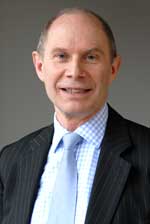 |
For everyone, whether policy-makers, utilities, vendors or constructors, the lessons of the past are being taken very seriously. We are all intent on making a success of this opportunity. In the past our industry had the reputation for expensive projects delivered late and over budget. One of the reasons for this was that many stations were unique. Each one intended to be an improvement over previous stations. The new nuclear build programmes are taking the lessons from the past and there is a strong desire for there to be |
|---|
'standard' designs for each design of reactor that are then built around the globe. In this way all but the first reactor avoids the 'first of a kind' (FOAK) syndrome. The supply industry is forming around a handful of reactor vendors each with this model in mind.
One fundamental question that this new delivery model raises is: Where does this leaves innovation? The nuclear industry is a technology-based industry and the lifeblood of all technology industries is innovation. As scientists and engineers we continually strive to improve. We are skilled at seeing the shortcomings or inefficiencies of previous designs and then working out better ways of doing things. But, in the new world of avoiding FOAK change is anathema.
The fact is, however, that the 'standard' global designs will not be identical around the globe. They will have to be modified for a number of reasons. For example, the site conditions for each station need to be taken into account; some countries operate on 50 cycles and others on 60 cycles, national safety regulators may demand modifications, some nations work to imperial standards rather than metric; etc. But the strong inclination will be to not change anything unnecessarily.
My observations focus on the building of new nuclear power stations. Of course, innovation will continue to be welcomed in the other sectors of our industry - nuclear medicine, decommissioning and plant operations. But it seems to me that, for new build, there is a real challenge for those of us in academia and research to explore those improvements in current designs that would be acceptable to current vendors and regulators whilst also pursuing those step changes in technology that will drive the next generation of global standard reactors.
http://www.euronuclear.org/e-news/e-news-26/listening.htm


On 19 August 2009, the Scottish edition of the Times featured an article whose title caught my attention. It read “Danish wind farm group blames island Nimbys for profit falls”. It reported that a large manufacturer of wind turbines was blaming “Not in my backyard” (nimby) reactions for falling sales in the United Kingdom. This was but one example of numerous wind mill rejections. So I thought, there is nothing personal against nuclear energy. Even the more popular energy sources can elicit the same rejection reaction as the more controversial ones. That was the good news. The bad news is that such behaviour is not sustainable. One cannot at the same time expect energy to be available at will and refuse to do what is needed to produce and transport it. Actually, one could argue that the said behaviour is not moral. The German philosopher Immanuel Kant (1724 – 1804) had an interesting way of telling whether an action was moral or not. His idea hinges on the concept of moral imperative, a formulation of which can be given as follows1:
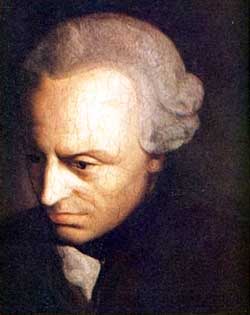
Let us first call “maxim” an action paired with its motivation. To say the same thing slightly differently, an agent's maxim, according to Kant, is his "subjective principle of human actions", that is, what the agent believes is his reason to act. Kant’s moral imperative then requires that the maxims be chosen as though they should hold as universal laws of nature. This formulation in principle has as its supreme law the creed "Always act according to that maxim whose universality as a law you can at the same time will" and is the "only condition under which a will can never come into conflict with itself"
It is possible to devise a test to decide if a maxim can have universal value. This test consists of five steps:
Find the agent's maxim (as defined above). Take for example the declaration "I will lie for personal benefit." Lying is the action; the motivation is to fulfil some sort of desire. Paired together, they form the maxim.
Imagine a possible world in which everyone in a similar position to the real-world agent followed that maxim.
Decide whether any contradictions or irrationalities arise in the possible world as a result of following the maxim.
If a contradiction or irrationality arises, acting on that maxim is not allowed in the real world.
If there is no contradiction, then acting on that maxim is permissible, and in some instances required.
In this context, the nimby reaction appears immoral indeed: it obviously cannot be willed as a universal law since it would imply the impossibility of building power plants or, for that matter, any industrial facility2.
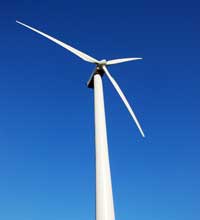 |
 |
|---|
It is difficult to understand why people can get so reluctant to sacrifice a small, nonessential part of their comfort to ensure essential needs such as energy. Surely several factors come into play, one of them being the fear of innovation. On that score, I remember having read about country people in Japan rioting against the erection of a lightning rod; the interesting thing is that this happened in… the seventeenth century! What is now taken for granted by everybody was then seen as a threatening device capable of entailing all sorts of evil consequences. Another reason resides probably in the decreasing utility of additional quantities of any good. Clearly people were less choosy at the beginning of the last century. The prospect of enjoying the convenience of electric lighting and other appliances was more than enough to compensate the small inconvenience of seeing a few electric poles through the window. If this interpretation is true, then it would follow that actual electricity shortages will be needed before people start reconsidering their opposition to power plants and high voltage lines. Yet another reason could be the unflinching support given by anti-nuclear activists to nimby reactions in areas mooted for hosting nuclear facilities. Such initiatives might have been instrumental in creating a nimby mentality that has survived its initial purpose. Should this assumption be grounded, it would provide further confirmation of two important principles. First, one should never use foul means to further one’s objectives, however commendable the latter might be (or appear to be). Second, beware of the unintended consequences of your decisions.
1 The explanation borrows heavily from Wikipedia’s article on Kant.
2 This is why “nimby” gets eventually further perverted into “banana” (build absolutely nothing anywhere near anybody).
http://www.euronuclear.org/e-news/e-news-26/hsc-statement.htm

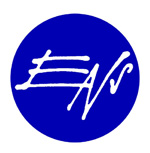
Last year saw a major worldwide crisis in the availability of medical radioisotopes. More specifically in the production of Mo-99/Tc-99m generators for diagnostic nuclear medicine. We will shortly analyse the causes of the shortage and point to necessary long-term measures to avoid future crisis.
When highly enriched U targets are irradiated in a high-flux reactor, a number of fission products are created, among which Mo-99 with a half-life of 66h. Radioactive decay of Mo-99 produces Tc-99m, a pure gamma emitter (140 keV) with a half-life of 6h. By separating Mo-99 out of the U targets, Mo-99/Tc-99m generators ('cows') are produced and shipped to hospitals worldwide. Some other production schemes exist, but their yield is much lower and the activity produced is too small to be of importance on the world market.
Tc-99m is used in about 80% of all diagnostic nuclear imaging procedures, corresponding to about 30 million examinations yearly worldwide, among which several million in Europe alones1.
Currently, the irradiation of the U targets allowing for the production of more than 90% of the available Mo-99 is performed in only 5 (MTR) reactors: NRU reactor in Chalk River, Canada; HFR in Petten, The Netherlands; BR2 in Mol, Belgium; OSIRIS in Saclay, France and SAFARI in Pelindaba, South Africa. All are older than 40 years.
The separation of the Mo-99 out of those irradiated targets is performed at 4 centres: AECL separates the Mo-99 in Chalk River and MDS-Nordion purifies it in Kanata, Canada; Covidien in Petten, The Netherlands; IRE in Fleurus, Belgium and NECSA-NTP in Pelindaba, South Africa.
The Mo99/Tc-99m generators are then manufactured and sold by a number of companies, among which the most important ones are now Covidien (formerly Mallinckrodt / TYCO Healthcare), Lantheus Medical Imaging (formerly DuPont / Bristol-Myers Squibb), GE Healthcare (formerly sold by Amersham) and IBA-Molecular (formerly CISbio International).
The NRU reactor produces about 40% of the required Mo-99. The three European reactors together produce 40 - 45% and the remaining amount is produced in South Africa and smaller actors. Given the operating schedule of the European MTR reactors involved, a coordinated European production calendar is fixed, ensuring a continuous production, provided of course that there are no incidents with the reactors or the processing facilities.
Other small irradiation/separation/production sites exist, but their market is purely local.
In August 2008, the HFR reactor in Petten was supposed to have been operational. Maintenance stops were underway as scheduled at BR2, OSIRIS and NRU. However, due to the discovery of corrosion and possibly small leaks in the primary circuit of the reactor, the HFR was not restarted. Independently, an incident occurred at IRE, during which about 37 GBq (1 Ci) of I-131 was released through the ventilation stack, without any adverse health effect for the workers and the population.
Suddenly, only one major irradiation facility (SAFARI; South Africa) remained available and one of the two European separation facilities was out, the other (Covidien) being stopped because of lack of irradiated targets.
After a few days, production resumed in Canada, but mainly for the North American market. Thanks to the efforts made by OSIRIS and BR2 for the irradiation of a maximum of U targets on the one hand, and the agreement by IRE for allowing Covidien to process IRE targets on the other hand, Covidien could resume operation at the beginning of October. After having received the authorization of the authorities, IRE could resume operation in mid-November. The HFR resumed operation in February 2009.
Due to this crisis, hundreds of thousands patients were denied diagnostic imaging tests based on Tc-99m. Some of the tests could be performed by alternative techniques such as PET, but at a much higher price. Others, by using less adapted radioisotopes. Most, however, had to be postponed or cancelled.
The crisis points to the alarming lack of production facilities for reactor produced medical isotopes.
In Canada, the NRU reactor started operating in 1957. The NRU reactor was scheduled to close down in 2005. AECL therefore designed and constructed two reactors dedicated to isotope production, Maple 1 and 2. Maple 1 was supposed to be operational by 1999. Due to major design errors, the operation of the reactors would have been unsafe. After several years of tests and design changes, AECL decided to stop the Maple project in 2008. Due to this, the operating licence of the NRU may be prolonged after 2011, even though it is now one of the oldest reactors still in operation worldwide. It is expected that the mandatory safety upgrades will require the NRU to be shut down for at least 1 year in the near future. Mid-February 2009, the NRU reactor was shut down once again for a few days due to a problem with the mechanism that extracts isotope-containing rods from the reactor. . The reactor was shut down mid-May because of a heavy water leak inducing Tritium releases through the ventilation system. The inspection programme of the reactor vessel has been performed, the analysis of the inspection data is in progress and the repair programme is under preparation. At this time, AECL expects the NRU to be restarted during the first quarter of 2010.
In France, OSIRIS will be shut down when the Jules Horowitz reactor (JHR) becomes operational. This is expected to be the case in 2014-2015. There should, therefore, be no discontinuity in irradiation facilities in France provided that the price asked for irradiating U targets in the JHR is commercially acceptable. In case of a long-lasting crisis, ORPHEE could also be used to produce radioisotopes for nuclear medicine. In 2009-2010, OSIRIS will undergo major maintenance work to allow its operation until 2015. An extended shutdown period of 5 months is foreseen in 2010.
In Belgium, BR2 is scheduled to operate at least until 2016 and there is no technical reason to stop its operation before 2020 at the earliest, provided that adequate fuel remains available and that the licensing authorities agree. At that time another multipurpose irradiation facility, MYRRHA, a multifunctional accelerator driven subcritical system (ADS), or ADONIS, a dedicated ADS, should be able to ensure continuous Mo-99 production.
In The Netherlands, after having been stopped for about six months due to corrosion problems, the HFR has been authorised by the Dutch regulatory authority to remain operational for an interim year until 1 March 2010 to allow for preparation of repairs. These operations are expected to last several months and scheduled to begin no later than in February 2010. In the meantime NRG is in the process of designing PALLAS as the replacement for the HFR reactor. The official target date for it is 2016, probable date at which the HFR will be stopped, but well informed sources doubt that this deadline is realistic as no formal decision concerning the construction or funding has been taken yet.
Several projects in the world could increase the availability of Mo-99 on the market at short-, mid- and long-term:
The new OPAL reactor in Australia is currently able to supply the domestic Mo-99 needs by the irradiation of LEU targets. ANSTO is actively working on a project to supply the US with Mo-99 in the near future.
The US is looking at the possibility to irradiate NRU targets in existing reactors such as MURR (University of Missouri; US) or HFIR (Oak Ridge; US), and to reprocess them in Chalk River (Canada) for Mo-99 recovery. The MURR research reactor, which was built in the early sixties, could produce about 50% of the US TC-99m needs. To commercially produce the isotope, MU would need to build and license a $40 million facility. Transport issues are involved.
The MARIA reactor in Poland made a feasibility study and should be able to irradiate U targets for the production of Mo-99 from 2010 onwards. The irradiated targets would have to be shipped to Petten (The Netherlands) for reprocessing and Mo-99 recovery. Transport issues have to be solved.
Other US initiatives exist on paper. Covidien announced an agreement with Babcock & Wilcox to study the development of an Aqueous Homogenous Reactor, or "solution reactor", which would be fuelled by low-enriched uranium (LEU) in place of highly enriched uranium (HEU) and dedicated to isotope production. It is not realistic to expect such a reactor to be built and be operational before 2020.
The South African SAFARI reactor is assumed to run until 2030. A project for SAFARI-2 exists but no decision has been taken yet.
The new FRM-II reactor in Munich (Germany) performed also a feasibility study and should be able to irradiate U targets for the production of Mo-99 from 2013. The irradiated targets would have to be shipped to Fleurus (Belgium) for reprocessing and Mo-99 recovery. Transport issues have to be solved.
Another project concerns the LWR-15 reactor in Rez (Czech republic) for target irradiation, which would have to be reprocessed elsewhere for Mo-99 recovery. Transport issues would also have to be solved.
Several projects have also been initiated by the IAEA to identify new potential Mo-99 producers in the supply chain. Two coalitions have been established: the EARRC (EURASIA Research Reactor Coalition) and the EERRI (East European Research Reactor Initiative).
The EARRC Isotopes Coalition is a new consortium of existing research reactors, isotope production facilities and market specialists that can make an important contribution to the shortage of Mo-99; The coalition will use the activation route 98Mo(n,γ)99Mo with natural and/or enriched 98Mo as target material.
The EERRI initiative was established in 2008 in line with IAEA efforts to improve research reactors utilisation through coalitions and networks. The production of Mo-99 in existing facilities is under consideration.
Other projects worldwide (Idaho State University, TRIUMF, ...) study the feasibility to produce Mo-99 using accelerators. The Canadian project of the TRIUMF group involves photofission of U-238 with a high power accelerator that could produce some 5% of the World demand.
Only a few of these projects will obviously been realized and they are not expected to generate an overcapacity of Mo-99.
A characteristic of the isotope production scheme is that none of the multipurpose reactors would be commercially viable thanks to isotope production alone. Up to now the only dedicated reactors built for a private company (the Maple reactors) turned out to have major technical design errors and, therefore, ended up to be financially disastrous. All reactors used today for isotope production are research reactors that have been paid for by public funds. A short analysis of the production and sales cost of Mo-99/Tc-99m generators is, therefore, relevant.
The price of nuclear medicine procedures obviously depends on the procedure, on the particular social security system and on other local factors such as transport costs. As an illustration, the Belgian price structure of a standard thyroid scan is given. It is followed with some data obtained by means of a small survey among nuclear medicine centres worldwide. The data mainly concern the price of Mo-99/Tc-99m generators.
Data on the cost of a thyroid scan with pertechnetate performed on an adult outpatient in a Belgian university hospital (the numbers given are rounded to the nearest integer):
Total price of a thyroid scan: 130 EUR
Cost to patient: 13 EUR
Cost to social security: 117 EUR
In this total price, the price of the isotope, as determined by the competent Belgian administration, amounts to 19 EUR or 13%. The price of the associated medical acts is 111 EUR or 87% and covers both instrumentation, personnel and overheads.
According to a 2008 US study (National research Council – prepublication data, Medical Isotope Production Without Highly Enriched Uranium)2, the cost for producing Mo-99 would range from about $125 to $325/Ci calibrated at 6 days3, or 2.6 to 6.7 EUR/GBq (at $1 = 0.78 EUR). The selling price of a Mo-99 Ci would be worth about $470 or 10 EUR/GBq.
In a small survey, data (8 in total) were received from Europe, North and South America, Oceania. Due to the small number of data, the statistical validity of the data is poor. Nevertheless, some conclusions can be drawn.
Averages have been calculated on the received data. Because conversion errors cannot be excluded, the averages have also been calculated on the data without the lowest and highest values.
Mo-99 generator activity: range 30 to 666 GBq.
Mo-99 generator price:
Range = 3.7 to 24 EUR/GBq; average = 12 EUR/GBq.
Without extremes:
range = 6.7 to 18.2 EUR/GBq; average = 11.5 EUR/GBq.
Part of the large variations can certainly be attributed to large differences in generator activity as well as to differences in transport costs. Other differences are due to market conditions and reimbursement schemes. A price of 6.7 EUR/GBq would put the 1Ci price at about $320, which is not incompatible with a production cost as estimated in the US study.
Tc-99m dose price, as estimated by the end-users:
Range = 2 to 19 EUR/GBq; average = 7.4 EUR/GBq.
Without extremes: range = 2.4 to 9.5 EUR/GBq; average = 5.8 EUR/GBq (= $ 0.27/mCi Tc-99m).
The variations reflect both the differences in generator price and the actual TC-99m activity eluted.
The respective contribution to the cost due to target irradiation, separation, assembling and distributing the generators is proprietary information and, therefore, absolutely not transparent. However, reliable sources state that the price asked for irradiation is a market price, which does most probably not cover the marginal cost, and certainly does not take the reactor investment and decommissioning costs into account. The irradiation is heavily subsidized. The irradiation price is roughly estimated to be between 5 and 10% of the cost of the generator.
The price of the separation phase seems, once more according to reliable sources, to be barely above the true cost. The benefit margin is said to be less than 5%.
Given the fast changes in generator providers (see above), assembling the generators and selling them does not seem to be a very lucrative business. Some respondents estimate the commission for the retailers to be around 20%.
In short, and for many years to come, European isotope production will remain fragile, as it is concentrated in only a few facilities, with the associated risk of shortage in case of facility failure. The fragility also comes from economics, since the isotope production is publicly subsidized by the limited number of countries hosting the facilities.
This situation calls for a political action, not only to secure the isotope supply, to pool the risks and loads linked to operation, maintenance, radwaste treatment and decommissioning, but also to organize the isotope distribution on a sound and equal economical basis.
Acknowledgement
This paper is based on an article by Frank Deconinck, Vrije Universiteit Brussel and Belgian Nuclear Research Centre (SCK•CEN); frank.deconinck@vub.ac.be; and Bernard Ponsard, Belgian Nuclear Research Centre (SCK•CEN); bernard.ponsard@sckcen.be, with suggestions of Henri Bonet (The National Institute for Radioelements, IRE, Belgium).
1 In diagnostic nuclear medicine, tracer amounts of a radioactive biologically active substance are administered to a patient. The tracer distribution is subsequently detected and visualised by means of a dedicated radiation detector, such as a gamma camera. The active substance is chosen in such a way that its spatial and temporal distribution in the body reflects a particular body or metabolic function and therefore allows inferring diagnostic information. The substance is labelled with a radionuclide to allow its detection. Only tracers are administered in order not to disturb the body functions. Examples are Tc-99m labelled red blood cells to study heart function, or Tc-99m labelled diphosphonates for visualising bone metabolism.
2 http://www.nap.edu/catalog/12569.html
3 to obtain 1Ci calibrated at day 6 means that, because of the Mo-99 half-life, at day 1 about 2Ci has to be produced. If the generator is delivered before day 6, the user gets a higher activity than charged for.
http://www.euronuclear.org/e-news/e-news-26/etrap2009.htm


ETRAP - Education and Training in
Radiation Protection
The Instituto Tecnológico e Nuclear and the European Nuclear
Society are organising the 4th international conference
on education and training in radiological protection, ETRAP2009, in Lisbon from 8 - 12 November 2009.
Register Now!
Education and training are
the two basic pillars of any policy regarding safety in the workplace.
ETRAP2009 will provide the necessary platform for a comprehensive
and transdisciplinary approach to education and training in radiological
protection.
The conference addresses the
largest potential audience, covering policy-makers, the medical sector,
industrial radiographers, NORM experts, the engineering sector, the
non-nuclear industry, social sciences researchers, safety experts, regulators
and authorities. Furthermore, it aims to reinforce the contacts between
various organisations, individuals and networks dealing with education
and training policies in radiological protection. Special attention will
also be paid to attracting and inviting young professionals to ensure
knowledge transfer and to help build the future of radiological
protection.
Delegates
at ETRAP 2009 will discuss all key areas of Education and Training in
Radiation Protection:
·
Current Status in E&T in Radiological Protection
·
Approaches in Sector Specific Training
·
Developments in Training Delivery
·
Recent Developments in Recognition and Harmonisation
of Requirements
·
Education and Training Networks
·
Building the Future – Attracting a New
Generation
·
Broadening the Perspective
More information on the
conference is available on the conference website:
www.etrap2009.org
An updated
conference programme is now available!
We are looking forward to
meet you in
http://www.euronuclear.org/e-news/e-news-26/pime2010.htm


At PIME 2010 delegates will be able to showcase their communications activities like never before! On 15 and 16 February 2010, the Hilton Hotel in Budapest will offer Pimers the perfect environment to display their communications activities, exchange ideas and network with their fellow communicators. Throughout the conference delegates will be able to use the extra space and range of audiovisual facilities on offer to present their innovative communications campaigns in the best possible light.
If a traditional poster exhibition is all you need, or if you prefer to bring a “mini exhibition stand” to promote upcoming events and display DVDs, computer graphics, and printed materials, PIME 2010 can offer you - at no extra cost - that added oxygen of publicity!
Just fill in this Communications Showcase form and let PIME 2010 provide you with the best possible platform for illustrating how you successfully connect with your audience and achieve your goals.
And don’t forget, if one of your campaigns was especially successful then why not also enter it for the 2010 PIME Award for Communications Excellence (link to PIME Award section)! Excellence should be shared with others…and get the recognition that it deserves.
PIME is the annual international conference for nuclear communicators across the globe. It provides delegates with a unique forum for networking and discussing with their fellow professionals the key communications issues that they face every day.
The programme for PIME 2010 is now available at www.pime2010.org!
http://www.euronuclear.org/e-news/e-news-26/rrfm2010.htm


The RRFM 2010 Programme Committee is calling for both oral and poster presentations in the following areas:
All Key Areas of the Nuclear Fuel Cycle of Research Reactors
Fissile material supply. Fresh fuel and targets: Origin and status, qualification, fabrication. Technical aspects of fuel in-core management and safety. Fresh and spent fuel transportation. Fuel and reactor licensing. Spent fuel storage, corrosion and degradation. Fuel back-end management. Innovative methods in research reactor analysis.
Innovative methods in research reactor analysis and design
Utilization of Research Reactors
Research Reactor Support for Innovative Nuclear Power Reactors and Fuel Cycles
New Research Reactor Projects
Research Reactor Operation and Maintenance
![]() Click here to download the RRFM 2010 Call for Papers
Click here to download the RRFM 2010 Call for Papers
We welcome both oral and poster submissions. If you wish to share your knowledge and insights with fellow-members of the research reactor community, please submit your abstract by 27.11.2009 through the RRFM 2010 Abstract Submission System.
The abstracts received will be peer reviewed under the auspices of the RRFM 2010 Programme Committee. Authors will be notified of paper acceptance by 19 December 2009.
Deadline for abstract submission: 27 November 2009
Notification of authors: 19 December 2009
Deadline for full paper submission: 19 February 2010
Deadline for submission of PowerPoint presentations: 12 March 2010
Conference: 21 - 25 March 2010
![]() Your full paper must be upload by 19 February 2010 at the very latest.
Your full paper must be upload by 19 February 2010 at the very latest.
![]() Your Powerpoint presentation must be in our possession by 12 March 2010 at the very latest.
Your Powerpoint presentation must be in our possession by 12 March 2010 at the very latest.
![]() Download instructions for authors
Download instructions for authors
The proceedings of RRFM 2010 will be published on the RRFM 2010 conference website, linked to the ENS website, with the reference number ISBN 978-92-95064-10-2.
RRFM 2010 Delegates will receive a CD ROM with the proceedings of the conference about 6 weeks after the event.
Please don’t hesitate to contact the ENS / RRFM 2010 Secretariat should you have any question:
Tel: + 32 2 505 30 54
Fax: +32 2 502 3902
e-mail: rrfm2010@euronuclear.org
http://www.euronuclear.org/e-news/e-news-26/enc2010.htm


Call for Papers
The European Nuclear Conference (ENC) is the largest international conference of its kind on the European event calendar. This European Nuclear Society (ENS) event has a multidisciplinary approach, looking at nuclear applications in energy production and medical technologies.
ENS and the ENC 2010 Programme Committee are now calling for abstracts in the following areas:
Reactor technologies
Generation III reactors
Generation IV reactors
Small reactors
Research reactors
Innovative reactor concepts, including the thorium cycle
Innovations in the supply chain or construction engineering
The fuel cycle
Front end
In core management and fuel behaviour
Back end
Spent fuel management
Uranium and plutonium recycling, including minor actinides transmutation
Transports of fuel materials
Nuclear materials safeguards
Greenhouse gas emissions from the fuel cycle
Plant operations
Maintenance and operation
Safety management (operation, maintenance, aging …)
Human and organizational factors
Materials technology and testing
Plant life extension
Instrumentation
Decommissioning
Physical protection
Life science applications
Protection of man and the environment
Radiobiology/radioecology
Instrumentation
Diagnostic and therapeutic applications
Isotopes supply
Radiation protection in medical applications
European harmonisation issues
Therapy with alpha emitters
Nuclear medicine training in Europe, present and future trends
Education, training and knowledge management
Initiatives in education, training and knowledge management
Education & training facilities
Challenges and opportunities for nuclear professionals
Recruitment and labour market issues
Nuclear and civil society
Countries’ perspectives on nuclear energy policy
Public information, including communicating on nuclear incidents
Public perception
Stakeholder involvement
Economical impact
Nuclear and the societal debates, including at international fora
Upload your abstracts before 13 November 2009 on www.enc2010.org or |
Important dates Deadline for
abstract submission: 13 November 2009
Notification of authors:
29 January 2010
Deadline for
full paper submission: 30 April 2010
Deadline for
submission of PowerPoint presentations: 21 May 2010
Conference: 30
May – 2 June 2010
Accepted
and presented papers will be included in the Conference Proceedings
(Transactions) that will be available on CD-ROM (after the conference)
and posted on our website: www.euronuclear.org with reference ISBN
978-92-95064-09-6.
|
Abstract review
The abstracts received will be peer reviewed under the auspices of the ENC 2010 Programme Committee.
ENC 2010 Programme Committee
Chair:
|
Conference
Secretariat:
65 Rue Belliard
1040
Tel. +32 2 505
30 54
Fax +32 2 505 39 02
http://www.euronuclear.org/e-news/e-news-26/TopFuel2009.htm


The following report on the jointly-organised GLOBAL 2009/TOP FUEL conference that took place in Paris from 6 – 10 September was compiled by Francis Sorin of SFEN and will be published in the next edition of Revue Générale Nucléaire. It summarises some of the main issues discussed, opinions exchanged and conclusions reached.
Paris recently played host to a nuclear conference that attracted 1,100 delegates from 34 countries, making it one of the most significant events of its kind ever to take place in Europe. This event, which took place in the Palais des Congrès, in Paris, provided a meeting place for nuclear professionals from across the world. It was the fusion of two separate events: the GLOBAL 2009 conference, entitled Sustainable Strategies and Future Prospects for the Nuclear Fuel Cycle Industry and the TOP FUEL 2009 conference, which focused on The Performance of Fuel used in Pressurised Water Reactors. Meanwhile, an exhibition held in parallel at the Palais des Congrès featured some of the world’s major industrial groups, companies and organisations active in the nuclear sector.
The joint event was organised by SFEN in cooperation with the IAEA and OECD/NEA and with the support of ENS and its members, the American Nuclear Society (ANS), the Atomic Energy Society of Japan and the Korean Nuclear Society. It is worth noting that on the agenda of GLOBAL 2009 was a session organised jointly with GIF (the Generation IV International Forum) that focused on the latest situation with regards to nuclear research and on the industrial prospects for Generation IV reactors.
In addition to this report the Revue Générale Nucléaire will also publish a more in-depth analysis of what was discussed during both jointly-organised conferences in its November/December edition (N°6/2009).
Here is an initial analysis of the issues discussed and of the exchange of views that took place in Paris. There was a significant degree of consensus in the conclusions reached and here is a summary of the main ones:
the fact that the event attracted 1,100 delegates is in itself highly significant as it sets, to our knowledge, a record over the last twenty years for attendance at a nuclear conference in Europe. In addition to the interest that was shown in the conference and the work of the organisers, the main reason for this record stems from the recent global increase in interest in nuclear energy. Its success reflects the nuclear “renaissance” (as the Anglo-Saxon media call it) and the new spirit of dynamism that underpins all sectors of nuclear activity
from an industrial perspective it now seems virtually certain that the operational lifetime for a nuclear unit can easily exceed forty years and even be extended to sixty years. This view is particularly strongly held in the USA, where almost half of existing nuclear units have been granted an extension of their operational lifetime to sixty years. Some people in the USA have even spoke about eighty years, or more. This would, of course, require the replacement and refurbishment of the main equipment.
When projected to the world’s total nuclear park, this extension of the operational lifetime of reactors will have a considerable effect upon total installed capacity. Indeed, new build programmes would no longer be seen as replacing decommissioned reactors but rather as increasing current capacity.
It is the safety authorities, however, who will have the last word as they alone are qualified to extend the operational lifetime of nuclear reactors. As far as France is concerned, the ASN is examining case by case the situation at every nuclear unit before it decides whether or not to grant an extension.
One conclusion that emerged from the debates during GLOBAL2009/TOP FUEL and during the joint session with GIF is that the recycling of fissile matter present in spent fuel could become the option of choice for completing the fuel cycle. The concept of a closed cycle with the treatment of spent fuel, the recovery of uranium and plutonium and the manufacture and use of MOX type fuel appears to be the best strategy for two obvious reasons: due to the economising of uranium resources and on account of the reduction in the final quantity of radioactive waste that is produced
A new debate on the question of non-proliferation has begun. It has led to the potential creation of a multinational organisation responsible for overseeing all sensitive operations related to the fuel cycle. The goal here is to prevent countries from building, alongside their electricity generating plants, installations like uranium enrichment plants and recycling plants that could encourage proliferation. What is called for is the creation of multinational centres, under international supervision, that will guarantee a whole range of so-called “sensitive operations” (i.e. enrichment, recycling, waste packaging) are carried out in all countries that have nuclear power plants. This multinational approach to overseeing sensitive nuclear operations seems to be the most effective means of preventing uncontrolled proliferation.
Contrary to popular opinion over the past four or five years, lots of young people are prepared to pursue a career in the nuclear sector. Recruitment campaigns underway in several countries have found no evidence of reticence among young professionals to opt for a job in the nuclear sector. Quite the contrary. In fact, this is what Anne Lauvergeon stressed during the inaugural session of the conference when she stated that AREVA was having no trouble recruiting thousands of employees each year, including graduates from renowned seats of learning and training centres. On a worldwide scale it appears that recruitment is progressing without difficulty. Bearing this in mind, however, it is important to manage effectively the transfer of knowledge. Occasionally, more senior professionals are called upon to help ensure that this successful transition takes place and to launch and complete specific projects. This calling upon the collaboration of more experienced professionals also highlights the reality of the nuclear revival….
The exchange of views that took place during the conference with delegates to the GIF symposium put the spotlight on R&D programmes that focus on the reactors of tomorrow and their potential commercialisation. These research programmes are being carried out in optimal circumstances and every indication points to the fact that some of these new reactors could be deployed as of 2030/2040. Several speakers underlined their desire to see these new reactors, which boast “revolutionary” performance levels with regards to safety, environmental-friendliness and operational flexibility, perform equally well financially, particularly when it comes to investment cost and the cost per kilowatt hour. The question of reasonable cost must be of primary concern to the designers of the reactors, otherwise the reactors risk being brilliant of concept but ultimately unusable due to their prohibitive cost.
For more information on the GLOBAL2009/TOP FUEL conference contact Francis Sorin of SFEN, keep your eyes open for the next edition of Revue Generale Nucléaire or visit the conference website.
http://www.euronuclear.org/e-news/e-news-26/HP-BWR.htm

Abstract
Some four hundred Boiling Water Reactors (BWR) and Pressurized Water Reactors (PWR) have been in operation for several decades. This concept the “High Pressure Boiling Water Reactor (HP-BWR)” makes use of the operating experiences todate. The HP-BWR combines the advantages and leaves out the disadvantages of traditional BWRs and PWRs by taking into consideration the experience that has been gained during their operation. The best components of both traditional reactor types have been retained and the more troublesome ones have been ommittedt. The main HP-BWR major benefits are as follows:
1. Safety is improved:
The control rods are gravity operated control rods
There is a large space for the cruciform control rods between the fuel boxes
The bottom of the reactor vessel is smooth and has no penetrations
All the pipe connections to the reactor vessel are well above the top of the reactor core
Core spray is not required - internal circulation pumps are used
2. It is environmentally-friendly:
Improved thermal efficiency, feeding the turbine with ~340 °C (15 MPa) steam instead of ~285 °C (7MPa)
Less warm water release to the recipient and less uranium consumption per produced kWh and, consequently, less waste is produced
3. It is cost effective and simple:
It features a direct cycle, so there is no need for complicated steam generators
The moisture separators and steam dryers are inside the reactor vessel and additional separators and dryers can be installed inside or outside the containment
Well-proven simple dry containment or wet containment can be used
Now the time has come to move a step further and develop an improved type of power reactor. Common sense, public confidence and economic considerations demand that this new design should not be a big leap forward from currently operating devices. However, it should be a significant improvement. Therefore, it is important to avoid those parts of the older designs which have caused trouble in the past e.g. PWR steam generators, BWR perforated reactor vessel bottoms, and instead rely only on a stable construction with proven components that have functioned well in the past. The HP-BWR (Figure 1) achieves these goals, by partly using the PWR concept, i. e. the pressure vessel, the electro-magnetic control rod operator, and by partly using the BWR concept, i. e. core internals, internal circulation pumps and steam and moisture separators. All the figures here are made by the combination of CAD models of existing BWRs and PWRs. The subject was introduced by the European Nuclear Society (ENS) as is outlined in References [1] to [4]
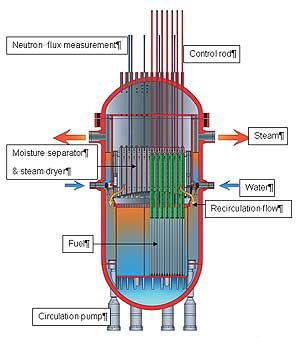
Figure 1, HP-WR
The control rods are gravity-operated instead of being operated by an intricate hydraulic system. The gravity-operated control rod system has served well in PWRs. The stems are introduced into the reactor vessel via the vessel head (Figure 2).
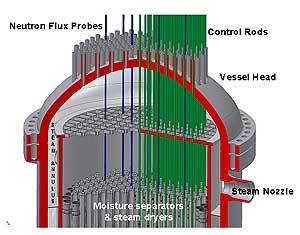
Figure 2, Vessel head
The control rods (Figure 3) themselves are cruciform, as is the case with BWRs. This assures large space for the cruciform rods between the BWR type fuel boxes. Also the neutron measurement sounds are introduced via the reactor pressure vessel head - once again as used in BWRs.
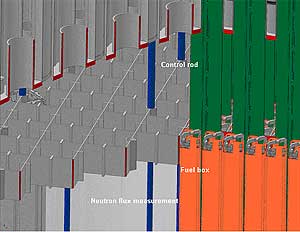
Figure 3, Control Rods
The bottom of the reactor vessel (Figure 4) is now smooth without numerous control rod penetrations, a great advantage compared with previous BWR designs.
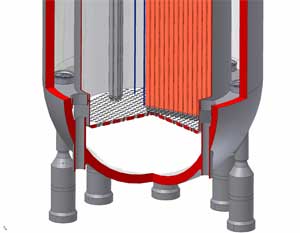
Figure 4, Bottom of the reactor vessel
All reactor vessel penetrations corresponding to different pipe connections are well above the top of the reactor core. This means that a major pipe break will not uncover the reactor core. Therefore a core spray system is not needed. In Sweden, for example, after receiving the approval of the safety authorities, the core spray system was removed in all internal pump BWRs were replaced by high pressure direct water injection in the Downcomer. Detailed studies of this subject are available at the Swedish Radiation Safety Authority.
Internal circulation pumps, located inside the reactor vessel and at the bottom of the Downcomer, are used to assure hydrodynamic stability. In this way, the orifices at the fuel channel inlets are chosen so that the single-phase pressure drop will dominate over the two-phase pressure drop and thereby avoid hydrodynamic oscillations. By utilizing natural circulation one could omit the circulation pumps altogether. However, the margin to avoid hydrodynamic oscillations may be reduced. This experience has been gained from several Boiling Water Reactors and is a phenomenon studied in thermal hydraulic loops at research institutes, universities and manufacturers
A thermal design criterion for a PWR reactor core is the limit of the fuel temperature (melting point of UO2 about 2800 °C), being the design temperatures 2000 °C at rated power and 2350 °C at a maximum linear fuel rating of 54 kW/m (see reference [5]). According to this criterion, recent PWR cores have an average linear fuel rating of 17.9 kW/m and maximum linear fuel rating of 44 kW/m. For a BWR, the maximum allowable temperature at the center of a fuel rod is 2500 °C in an emergency and 1850 °C during normal operation (see referemce [5]).
Following this criterion, a HP-BWR with a thermal power of ~2700 MW, and an electrical power output of ~1000 MW, may have a core with an average linear fuel rating of 13.6 kW/m and a maximum linear fuel rating of 44 kW/m. Without any fuel modifications, the temperature at the center of a fuel rod during normal operation is slightly higher and has been estimated to be 1885 °C. The maximum temperature of the Zircaloy-2 fuel cladding is around 491 °C, which is lower than the allowed maximum temperature of 550 °C.
A detailed comparison of the HP-BWR concept against modern PWRs and BWRs is given in Refence [5]
The HP-BWR has further advantages, namely improved thermal efficiency due to the higher temperature and further improved inherent stability due to the increased negative power reactivity coefficient. Table 1 shows a comparison - calculated with the RELAP5 (Mod3.3 Patch02) and PARCS codes - between a BWR and a HP-BWR. (see Table 1)
Table 1, Comparison between BWR and HP-BWR, calculated with the RELAP5 (Mod3.3 Patch02) and PARCS codes.
BWR |
HP-BWR |
|
Feed water temperature |
486.6 0K |
486.6 0K |
Outlet void temperature |
599 0K |
617.8 0K |
Pressure in the steam dome |
7 MPa |
15.5 MPa |
Inlet temperature to the core |
550.29 0K |
582.3 0K |
Inlet core quality |
-3.909E-02 |
-0.254 |
Outlet quality from the core |
0.128 |
0.323 |
Total Mass Flow Rate from the core |
13634 [kg/s] |
5955 [kg/s] |
Total Mass Flow Rate in the steam lines |
1795 [kg/s] |
2026 [kg/s] |
Total Mass Flow Rate through the pumps |
13634 [kg/s] |
5955 [kg/s] |
Total Power Coefficient |
-1.64e-4[Δk/%] |
-4.4e-4Δk/% |
The axial power distribution calculated with the RELAP5 (Mod3.3 Patch02) and PARCS codes, is similar in both types. See figure 5
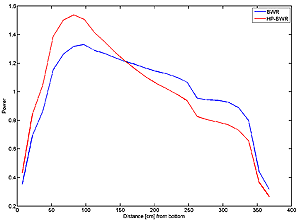
Figure 5, Axial power distribution in HP-BWR and BWR, calculated with the RELAP5 (Mod3.3 Patch02) and PARCS codes
Ever since the onset of the nuclear power era, negative power coefficient has been considered a virtue, because it means that the reactor will close itself when there is a perturbation - even without the use of the control system. It is reassuring both for the nuclear engineer and the public that the security level of the reactor is satisfactory. After the out-of-control Chernobyl accident the value of the negative power coefficient was even more accentuated. The HP-BWR has a more negative power coefficient (pcm/%) than the traditional BWR and PWR.
At 150 bar the gradient on the saturated water density vs. saturation temperature curve (kg.m-3/0C) is steeper than at 70 bar (the derivative is more negative), resulting in a more negative moderator temperature coefficient (pcm/0C). See Figure 6.
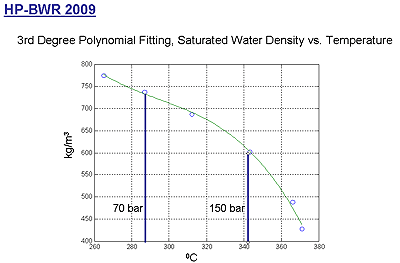
It is obvious that the gradient kg/m3/°C at 150 bar is steeper then at 70 bar
Figure 6. Saturated water density curve, the derivative is more negative at 150 bar than at 70 bar
The value of the negative void coefficient (pcm/%) is about the same for both types of reactors. However, the control algorithm for the pumps’ speed and for the control rods’ movement might need to be modified compared with a traditional BWR.
Thermalisation of the fission neutrons is successfully accomplished at 150 bars in the traditional Pressurized Water Reactors. PWRs contain not only water, at about a mere ~20 0C below saturation temperature, but also a lot of bubbles, due to subcooled boiling.
“Simple is beautiful” as 150 bar is far away from the critical pressure (~214 bar) the design is simple and thereby safer and more economical.
In Figure 7, the results of transient calculations made with the MATLAB code shows the HP-BWR’s long term stability without the use of any control system. BWRs are operated in an under-moderated condition and have, therefore, a strongly negative void coefficient of reactivity. This coefficient is a function of the core design, void location and void volume, which can be adjusted to an appropriate magnitude when the operating pressure is increased from 7 MPa to 15 MPa.
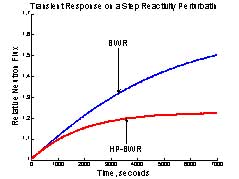
Figure 7: Long term stability without the use of any control system calculated with the MATLAB code (inherently stable reactor).
Improved thermal efficiency is attained by feeding the turbine with steam at 343°C (~15MPa) instead of 286 °C (~7MPa). A rough estimate of the efficiency may be obtained through a calculation of the Carnot cycle theoretical efficiency (THot - TCold)/ THot. This gives for a BWR ~ 46 % and for the HP-BWR ~ 51 % at Tcold = 300 K, i.e. an increase by a factor of 1.109. Assuming the same improvement ratio, today’s efficiency of ~ 33 % would increase to ~ 37 %, which is supported by the analysis that follows on from the Rankine cycle efficiency (see Reference [5]).
The same results are obtained with a separate Rankine cycle calculation which is given in Reference [5]. This underlines the advantage of the HP-BWR, which uses the fuel more efficiently and releases less warm cooling water to the environment per produced kWh and, consequently, produces less waste. There are several conventional thermal power plants with 15 MPa turbines.
The HP-BWR operates in direct cycle mode, with no need for complicated and expensive PWR steam generators. Furthermore, instead of the rather complicated BWR reactor pressure vessel bottom, a more simplified one is used. The main steam separators are inside the pressure vessel and secondary separators and dryers can be installed outside the reactor vessel, inside or outside the containment. The containment can be a simple dry containment (Figure 8) which allows easy entrance and inspections and also minor repairs during operation.
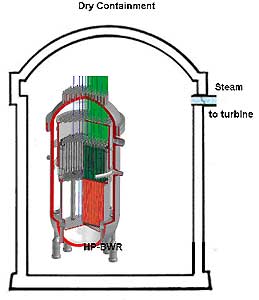
Figure 8: HP-BWR in a dry containment
Naturally the HP-BWR fits into a usual wet containment environment too. Also, when considering the refurbishment of an old BWR the HP-BWR fits the picture well. Se Figures 9 and 10.
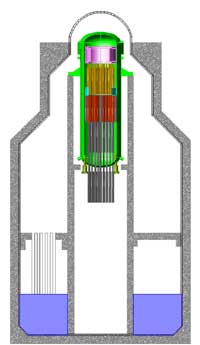
Figure 9. The closed Barsebäck BWR
There has been a suggestion to refurbish Barsebäck with a HP-BWR, which received the aproval of the Swedish and Danish people.
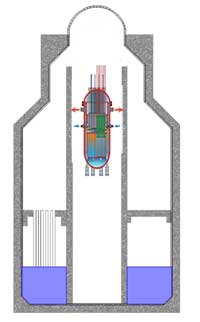
Figure 10. Proposal to refurbish Barsebäck with a HP-BWR
In this report a concept of a High Pressure BWR has been put forward that combines several advantages while avoiding some of the weaknesses of conventional BWRs and PWRs. This has been discussed and analyzed. However, some clarifying remarks should be added to complete the analysis.
The author is convinced that the experience gained during so many years of operating conventional light water reactors constitutes an unprecedented source of knowledge that new reactor concepts lack to a large extent. Conventional light water reactors may still be redesigned and optimized based on this knowledge, and the present concept provides a clear example of just such a possibility. Knowing how the different materials behave under prevailing reactor conditions and how to design the different components (the reactor vessel, the control rods etc.) from a structural mechanics point of view are examples of the advantages offered by using a reliable technology.
The HP-BWR concept also implies higher pressure and temperature for the turbine-generator plant then for the traditional BWRs and PWRs. Modern conventional thermal power plants with supercritical steam/water conditions (25 MPa and 560 °C) are generally employed. This indicates that the possibility exists of developing a steam cycle that could fit the steam conditions delivered by the HP-BWR.
Finally, one question remains to be answered - why has this concept of increasing the pressure and temperature of a BWR not yet been considered by the industry? Industry’s interest in lowering costs by increasing the total power of the reactor, rather than by increasing its efficiency, may have played a part in this issue. Probably in the past it was thought that an efficiency increase did not justify the necessary design and licensing effort. Now, with increasingly demanding environmental requirements the industry may be willing to reconsider this alternative.
Thanks to Hernan Tinoco and Karl–Axel Bartholf of the Forsmark NPP for the CAD models and to Tomasz Kozlowski and Joanna Peltinen of KTH for the RELAP and PARCS calculations
IAEA
I would like to thank the IAEA for the opportunity that was given to me - as a reactor inspector on leave from Sweden – to become an IAEA employee and to participate in IAEA’s OSART and ASSET missions. Also, as an active member of the International Electrotechnical Commission (IEC) I was given the opportunity to visit nuclear installations in Europe, Asia and America. In this way it was possible for me to gain an insight into the operational experiences of most reactor types. This was all crucial in helping me to write this report.
[1] ENS News, October 2007
www.euronuclear.org/e-news/e-news-18/HP-BWR.htm
[2] Transactions of the European Nuclear Conference (ENC) 2007, Brussels
www.euronuclear.org/events/enc/enc2007/transactions/transactions-posters-enc07.pdf
[3] ENS, April 2008, HP-BWR
www.euronuclear.org/reflections/HP-BWR.htm
[4] Transactions of the European Nuclear Society (ENS) Conference TOPSAFE 2008
www.euronuclear.org/events/topsafe/transactions/TopSafe2008-transactions.pdf
[5] Proceedings of the 17th International Conference on Nuclear Engineering, ICONE 17, July 12-16, 2009, Brussels, Belgium, ICONE17-75032
www.asmeconferences.org/icone17/
Bibliography
Nuclear Engineering International, 9 April 2009
The Best of Both, by Frigyes Reisch
www.neimagazine.com/story.asp?storyCode=2052686
Paolo Ferroni, Neil Todreas. Massachusetts Institute of Technology,
Joint Reactor Seminar University of Tokyo (GoNERI) and UC Berkeley. March 5, 2009
Improved BWR Core Design Using Hydride Fuel
Massimiliano Fratoni, Alessandro Piazza, Ehud Greenspan, University of California, Berkeley
goneri.nuc.berkeley.edu/tokyo/2009-03-12_Fratoni.pdf
http://www.euronuclear.org/e-news/e-news-26/nuc-energy-enviroment.htm

Among the scientific meetings that were organized recently on the occasion of the state visit to Romania of Their Majesties the King and Queen of the Belgium, one of the more significant ones was a Romanian-Belgian seminar entitled Nuclear Energy and the Environment. It took place in one of the conference rooms at the Cercul Militar of Bucharest, on Wednesday, July 8. The event marked a new phase in the further strengthening of the links that have been forged between Belgium and Romania by institutions and companies involved in the field of nuclear energy. These links were established a long time ago and the signature of two new Memorandums of Understanding (MoUs) will provide further evidence that this lasting tradition of cooperation remains as strong as ever. Events like this seminar are necessary for sharing increased knowledge of joint activities and issues with a broader audience beyond those directly involved.
The first part of the seminar was a session shared jointly with another important and interesting seminar entitled: Energy resources for the future: the Belgian and Romanian perspectives. Firstly, introductory speeches were given by the two chairmen, Prof. Michel Giot, President of the Scientific Council of SCKCEN (Belgium’s Study Center for Nuclear Energy) and Emeritus Professor at the Catholic University of Louvain (Belgium), and Prof. Adrian Badea, Pro-Rector of the Politechnica University of Bucharest. After that, a series of general presentations were made in order to outline the current framework, objectives and concerns of both countries with regards to power production over the next few years. The presentations focused on two of the 20-20-20 targets established by the EU, namely reducing the EU’s overall greenhouse gas emissions to at least 20% below 1990 levels by 2020, and increasing the share of renewables in the energy mix to 20% by 2020. The presentations were given by Prof. William D’Haeseleer, of the University of Louvain and by Alexandru Sandulescu, Director General for Energy Policy at the Ministry of Economy. They highlighted the challenges faced by both countries, the costs involved and the consequences of not using nuclear energy. It was especially interesting to note that the “unsustainable” phase-out of nuclear energy will be paid for not only by Belgium and other states that share the same objective, but by all EU Member States. Within this context Romania is worried by the 55% share of energy production that is attributable to fossil fuels in Romania and by the great difficulties it faces in quickly changing round this figure in order to meet the relevant 20-20 target. During the presentations Romania’s intention to finalise the two additional units at Cernavoda NPP by 2015-2016 and to build a second NPP in 2020 was also underlined.
The second part of the seminar was chaired by Prof. Frank Deconinck, Chairman of SCK-CEN, and by Dr. Lucian Biro, Director General of CNCAN. It focused on specific nuclear activities and issues. Dr. Gheorghe Negut from ANDRAD presented Romanian waste disposal projects. Dorin Filip, from Uranium –CNU (Romania’s national uranium enterprise), presented the environmental impact of uranium mining. Dr. Nicolae-Victor Zamfir, General Director of the Institute for Nuclear Physics and Engineering (IFIN-HH), then summarised the importance of radiological emergency planning.
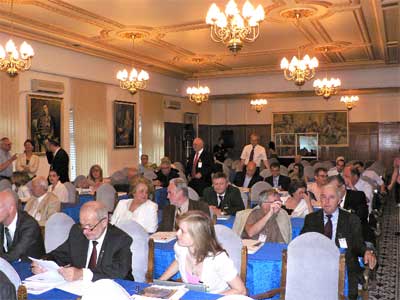
Next on the agenda was a presentation by two SNNSA representatives, Dr. Vasile Simionov and Cristina Bucur. They are acknowledged experts on the Cernavoda NPP project and highlighted the excellent performance of Cernavoda in terms of the negligible environmental impact that is causes. The results are well below the standard radiological limits permitted and this - coupled with the strict administrative constraints that the plant applies to its operations - creates a great degree of public confidence in this major energy producer, thereby increasing public acceptance of nuclear power. The seminar concluded with an excellent exposé by Rik Van Brabant, Director of Belgoprocess, of the cooperation that has long existed between Belgium and Romania and of the prospects for the future.
In his closing speech, Prof. Deconinck stressed the effectiveness of such meetings as a means of promoting a bilateral exchange of ideas and experience and as a vector for encouraging further collaboration in the future. Dr. Biro called for of a strategic programme for developing this partnership with an accent on increasing synergy and concerted joint efforts from both sides.
The conclusions of the whole Academic Forum, of which the seminar on nuclear energy was a component, were outlined in a special session that took place in the presence of His Majesty Albert II, King of the Belgian. Other presentations were made by senior Romanian officials, Cristian Diaconescu, Ministry for Foreign Affairs and Mugur Isarescu, Governor of the National Bank. This was followed by the official signature of contracts and MoUs between RAAN-SCN, IFIN-HH and SCK-CEN.
From October 12-16, Bucharest, the capital of Romania, hosted the latest edition of the International Symposium on Nuclear Energy, SIEN 2009 - an international conference for specialists from all sectors of the nuclear community.
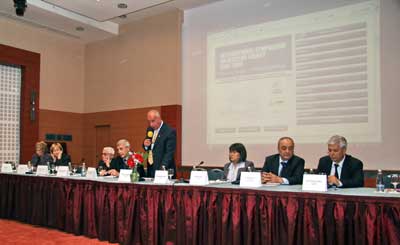
The event was sponsored by: AECL Canada, Ansaldo Nucleare Italy, Elcomex Romania, General Concrete Romania, General Turbo Romania, KHNP Korea, Nuclearelectrica Romania, RWE Germany, SNC Lavalin, Siveco Romania, UTI and the Politechnica University of Bucharest. It is organised every two years by the Romanian Association “Nuclear Energy” and by the Romanian Atomic Forum, in cooperation with various sponsors, including Nuclearelectrica, AECL and ANSALDO. This year’s conference took place under the aegis of the European Nuclear Society.
Nuclear power represents almost 18% of Romania’s internal power consumption. Since the completion of the Cernavoda NPP’s Unit 2 in 2007, the Romanian nuclear industry has been experiencing a “post-renaissance phase.” The announced new project for the construction of Cernavoda units 3 and 4 and that of the second Romanian NPP has attracted foreign companies such as AMEC, SNC Lavalin, Iberdrola and RWE – all of whom have subsidiaries in Romania.
SIEN 2009 conference focused on issues of interest, such as nuclear new build and current developments, the fuel cycle, decommissioning, nuclear safety, operational aspects, inspection and maintenance and public perception and acceptance.
In addition to the symposium, WIN (Women in Nuclear) Romania and the Young Generation (YGN) chapter in Romania organized specialised workshops focusing on the role of education and knowledge transfer in the nuclear field and also on the possibilities for attracting more students and young professionals to nuclear power, particularly within the context of above mentioned new projects. During the workshops conference delegates elected a new management team for the Romanian YGN. Ionut Zaharov, a nuclear engineer, took over the presidency from Andrei Goicea, who was elected in June as Vice-president of ENS-YG. Corina Bararu was elected the new Vice President.
Two other workshops were organized in connection with the symposium, one dedicated to implementing the Aarhus Convention in Romania’s nuclear sector, and another related to compliance with IAEA management requirements as part of European integration.
SIEN 2009 was attended by around 200 participants. There was a significant contribution from Romanian companies as the Research Institute at Pitesti, the Politechnica University of Bucharest and the Radioactive Waste Management Agency. But foreign companies were also well represented, including the CEA and AREVA from France, RWE from Germany, AECL from Canada, Ansaldo from Italy and KHNP from Korea.
The programme on the last day of the conference gave delegates an opportunity to visit two important nuclear facilities in Romania: the Cernavoda NPP and the Nuclear Fuel Plant in Pitesti.
SIEN 2009 was a great success. It provided an opportunity for top-level scientists to exchange experiences and information and to network with their fellow professionals.
http://www.euronuclear.org/e-news/e-news-26/sck-cen.htm

 |
Space flight research at the Belgian Nuclear Research Centre – SCK•CEN |
|---|
The Belgian Nuclear Research Centre is one of the largest federal research centres in Belgium with laboratories in Mol and a registered office in Brussels. More than 600 employees advance the peaceful industrial and medical applications of nuclear science. The purpose: to maintain and expand a centre of excellence for nuclear research. In particular the research focuses on the safety of nuclear installations, safe treatment and disposal of radioactive waste, protection of man and environment against ionising radiation and the control of fissile and other strategic materials.
The acquired knowledge is spread through education and communications. SCK•CEN analyses the social implications of its research in the pursuit of sustainable development. It uses its know-how and infrastructure to provide services to the government and the industrial and medical sectors. In addition, SCK•CEN is a partner in several international research programs.
In-space weightlessness and high cosmic radiation can influence the health of astronauts and the environment in which they live. SCK•CEN plays an important role in the field of microbiology, human biology and dosimetry in space and is also member of the Flemish Space Industry organisation. Its gathers together companies, research centres and education institutes operative in the space market.
For some years now, scientists have been searching for a solution to problems that arise during long space missions. Hence SCK•CEN is participating in the development of the MELiSSA project. This is a group of interconnected biological reactors with 4 compartments for the purification and recycling of air and water and for the production of food, using bacteria and plants. SCK•CEN is doing research through experiments on earth and in space. In this way, the correct functioning of the bacteria in the bioreactors in space conditions, including the higher cosmic radiation and the weightlessness, is studied. It is extremely important to be able to guarantee the liability of the system and thus the safety of the astronauts who have to rely on it.
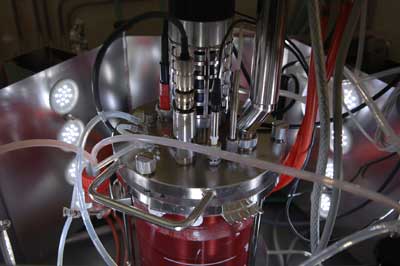
Melissa-project
Micro organisms can cause also in space infections and diseases and can damage structural materials, even destroying or corroding them. Therefore, SCK•CEN works together with European, Russian and American scientists to map the amount and the type of bacteria and fungi present in closed space capsules, in order to develop in the future new prevention, detection and remediation methods.
Scientists know that a space travel has an influence on the human body. Next to cosmic radiation and weightlessness, stress factors like living in a closed environment, work load and disturbed sleep and eating patterns, can also cause problems. A space journey affects amongst others the immune system of the astronauts. What this is due to and which mechanisms play a role needs further examination. In cooperation with European, American and Russian space agencies, SCK•CEN measures, in the astronauts blood, the influence of a long stay in space.
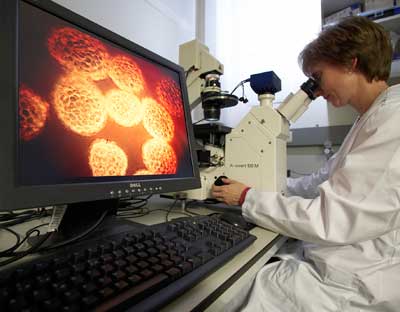
Radiobiological research
Can astronauts get pregnant in space and can the embryo develop normally? To be able to answer this question, a team of ESA will study the biological development of vertebrate organisms in space conditions. 33 laboratories are involved in this project. They will investigate the physiology, molecular biology, biochemistry and behavioural apsects in all development stages of the embryo. SCK•CEN contributes with its extensive experience in the field of radiobiology, embryology and molecular biology. The mouse is a good model for research in human embryology and is frequently used in molecular, biochemical and pathological studies.
SCK•CEN sends regularly dosimeters to the ISS with the Space Shuttle and the Soyuz capsules. These dosimeters stay there for a couple of days up to a couple of months and are afterwards analysed on earth. In this way dosimeters have been attached to the outside of the ISS for more than one year now. The study is being carried out in cooperation with other international laboratories. Measuring the radiation field outside a space station is unique. In the meantime, several radiation sensors and techniques are tested to improve the measurement of cosmic radiation.
More information is available at: SCK•CEN: www.sckcen.be
Space research on SCK•CEN: www.sckcen.be/en/Our-Research/Research-domains/Radiation-protection
Contact: info@sckcen.be
http://www.euronuclear.org/e-news/e-news-26/SNE-news.htm

 |
SNE news |
|---|
The Spanish Government recently decided not to renew the operation license of the Santa María de Garoña nuclear power plant beyond July 2013.
In Spain, permits to operate nuclear power stations are renewed in accordance with established procedures. The current operating license of the plant established the conditions under which the company could obtain an operating extension. Although Nuclenor met these conditions satisfactorily, as borne out by a favorable opinion issued by the Nuclear Safety Council (CSN) on 5 June 2009, the government took the decision not to authorise a 10 year extension.
In the opinion of Nuclenor this decision represents a departure from the conditions established in the above-mentioned procedure. Consequently, the power plant’s board of directors has taken official legal action against the government’s decision. Professional associations, plant workers and other organisations have also expressed their opinions in favour of keeping the plant running beyond 2013.

The decision taken by the government is the result of a political strategy against nuclear energy carried out by the Socialist party in Spain. This party presented as part of its electoral manifesto a plan to close Spanish nuclear power plants at the end of their 40-years operational lifespan.
On the other side of the political spectrum, the national Right-wing party (Partido Popular), represented by its leader, Mariano Rajoy, stated that nuclear energy is the only option for Spain to meet its future energy demand. Mr. Rajoy also declared that the pre-condition for the Partido Popular supporting the government’s future plans for energy production is the renewal of the Garoña power plant’s operating license.
The Spanish Nuclear Society (SNE) also put out a press release stating that the government’s decision is not consistent with any technical, economical, social or environmental rationale but is instead a politically motivated decision.
The Spanish Nuclear Society’s opinion on the issue and other documents can be downloaded from the SNE web site at www.sne.es
For more information about this topic you can visit the following website: www.csn.es and those of the institutions and companies mentioned in this article.
The 35th Annual Meeting of the Spanish Nuclear Society, took place in Seville from 28 - 30 October 2009. The conference programme included plenary and technical sessions. The plenary sessions focused two issues of Spanish Energy Prospects for 2030 and New Nuclear Programmes.
The technical sessions took place on all three days of the Annual Meeting and where grouped together by topic. During these sessions nuclear professionals from Spain and other countries updated delegates on the latest developments. The technical issues discussed during the 35th Annual Meeting of the Spanish Nuclear Society were as follows: fuel, communications, dismantling, fusion, R+D, engineering, maintenance, nuclear medicine and other applications, new reactors, NPP operation, management and human factors, radiological and environmental protection, nuclear waste and nuclear safety.
More than 230 presentations were given during the technical sessions and more than 550 representatives of different companies, universities and institutions took part in this year’s event.
In the commercial exhibition that will ran in parallel throughout the three days of the meeting almost thirty companies and institutions presented their latest innovative activities. The exhibition will be held at the Barceló Renacimiento Hotel.
The Spanish Nuclear Industry Forum has created a digital platform called yosoynuclear.org (in English: “I am nuclear”) to promote the nuclear debate. This platform is made up of people representing all social sectors: citizens, consumers, web surfers, companies, students, academics, businessmen, and nuclear professionals. The main object of the initiative is to give a possibility to citizens to discuss nuclear energy and to facilitate a dialogue between people who are both for and against this source of energy, as well as those who have no particular opinion on the issue. The platform also seeks to create a space on the Web for all opinions to be expressed and where citizens interested on this issue can find some accurate and objective information.
In yosoynuclear.org, signatures from people wanting to support actively the use of the nuclear energy can be collected. The platform will try also to encourage the debate about future energy options in Spain without any dogmatism and by encouraging people to present their proposals, ideas and suggestions in a way that helps to maintain a transparent and objective debate.
http://www.euronuclear.org/e-news/e-news-26/ygn.htm


The 12th Edition of the International Conference on Environmental Remediation and Radioactive Waste Management was held in Liverpool, England, from 11-15 October 2009. The conference was jointly organised by ASME, the Institute of Mechanical Engineers and the Nuclear Institute (NI).
This conference is one of the most important ones currently on the conference agenda dedicated to the subject of waste management, decommissioning and dismantling (D&D). There were many topics covered in the 63 sessions included on the agenda. These were: L/ILW characterisation, treatment, regulatory compliance, packaging, vitrification and alternatives, environmental remediation, spent fuel programmes and HLW management, research and power reactor decontamination, dismantling and decommissioning, national and international programmes, disposal sites and repository programmes, local participation and decision-making, behaviour and politics, dialogue, and risk communication.
The UK&NI Young Generation Network (YGN) ran a panel session entitled Young Generation Networks and Professional Development. Corhyn Parr (UK YGN Vice Chairman) opened the session with a presentation on the results of a survey on attitudes and opinions towards the nuclear industry in UK made by NI YGN members. One of the conclusions of the survey was that young professionals now think that there are more opportunities in UK than abroad. Carl Dawson, from the Nuclear Decommissioning Authority (NDA), talked about the NDA ‘nuclear graduates’ programme, the reasons why it was set up and its plans for future development and expansion. This was followed by Susan Elder (NDA), a member of one of the first cohorts of ‘nuclear graduates,’ who talked about her experiences with the programme, the challenge of knowledge transfer between generations and shared learning between graduates.
Finally, Miguel Millán, General Chairman of the Spanish YGN (Jóvenes Nucleares, JJNN) showed the process and evolution by which the Spanish YGN have become a technical reference in Spain for companies, media and public opinion.
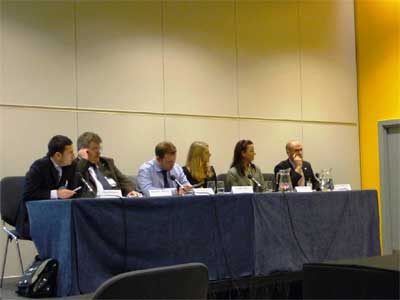
The YGN Panel
Miguel presented the current situation in Spain, where only 24% of the population support nuclear energy. He pointed out that, faced with such a difficult environment, the main objective of JJNN is to promote a growing and significant number of people who can learn about this technology, because fair and objective knowledge is clearly needed to make a judgement, to draw conclusions and to make choices about such a complex matter. At the same time if that information is not available it will never be possible to reduce the reluctance of Spanish society to embrace nuclear energy.
Within this context Miguel presented how JJNN realised that all relevant parties must be involved in an open and transparent debate on nuclear issues and underlined that JJNN seeks to provide information, and objective scientific and technical data, nothing more and nothing less. JJNN leaves the important task of deciding and choosing up to the people. Miguel stressed the fact that his organisation is primarily composed of members with a strong scientific and technical background and it is precisely this technical knowledge about nuclear industry that is the key to their credibility.
Another important aspect of JJNN is its youth and its consequent empathy and energy. Finally, Miguel said what best summarises the spirit of the organisation with the words: “Much more important than what we say -even if we are right- is the credibility that we gain from being fair”.
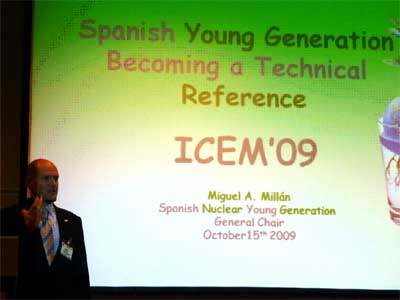
Miguel Millán during his presentation
Spanish YGN
Jóvenes Nucleares
http://www.euronuclear.org/e-news/e-news-26/Swiss-YG-Project-2009.htm

On 25 September, the Swiss Young Generation Project 2009 was started. It is the largest training course offered by the Swiss Nuclear Society’s Young Generation Network. This is the fourth year running that the project has been organised, after achieving great success in the past. Ten young professionals from six companies and organizations met at the kick-off meeting at the Böttstein Convention Centre, next to the NPP Beznau, to work intensively on two main topics:
Renewable energy, nuclear energy and CO2-emissions in Switzerland
Final disposal in Switzerland
The two main topics were introduced by experts in their respective fields: Dr. André Vossebein, who is responsible for strategic energy management at the Axpo Holding AG, presented the future potential for Switzerland of various forms of electricity production and the effect that each has on the CO2-balance. Dr. Piet Zuidema, who responsible for technology and research at Nagra (National Cooperative for the Disposal of Radioactive Waste) presented the latest research status in Switzerland with regards to waste storage sites, as well as the political and public process that underpins their realisation.
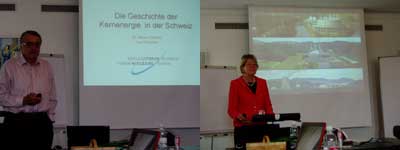
Two working groups have been formed to present, over the next two months, scientific papers and presentations on each of the main topics. The experts will support the groups with their work. The finished papers will be presented at the final meeting of the Young Generation Project, in mid-November and at the International Youth Nuclear Congress (IYNC 2010) in Capetown, South Africa. In addition, two further presentations were made at the kick-off meeting in Böttstein: Corina Eichenberger, a member of the Swiss Parliament and President of the Swiss Nuclear Forum, gave an insight into Swiss energy policy and the future role of nuclear energy in the production portfolio. Dr. Bruno Pellaud, former Deputy Director General of the IAEA and former President of the Swiss Nuclear Forum, gave a lecture on the history of nuclear power in Switzerland.
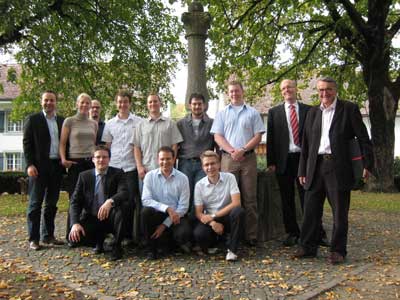
Since the Young Generation Project 2009 kick-off meeting the two working groups have started preparing their respective papers and presentations. The Swiss Nuclear Society’s Young Generation Network is looking forward to the final meeting in mid-November.
Thomas Winkler, member of the Board of the Swiss Nuclear Society’s Young Generation Network
http://www.euronuclear.org/e-news/e-news-26/bns-yg.htm

The Belgian Nuclear Society – Young Generation Network (BNS-YGN) brings together young nuclear professionals and students from the industry and research organisations with a view to enabling them to gain access to nuclear knowledge and to enhance the transfer of know-how. Recently our network has grown significantly. Today, BNS-YGN - a core group with representatives from the different companies and institutions in the Belgian nuclear field - is made up of about 30 members. This group is the driver of the network and organises BNS-YGN evening lectures, technical visits, the annual master thesis contest and other events.
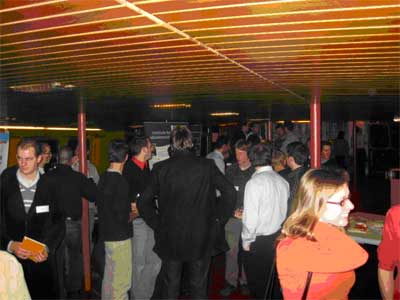
The BNS-YG Networking Event in the Antwerp Port (March 5, 2009)
In order to make itself better known to an expanding network, BNS-YGN organised a first networking event in March 2009, on a boat in the port of Antwerp. During the event the nuclear sector was presented by young professionals to young professionals. In addition, the participants got together to network during an informal drink. The evening was a success, with 110 people from different companies in attendance. It showed that there is considerable interest in the BNS-YGN and its mission. Although Antwerp is not in the middle of the country, enthusiastic participants from all over Belgium were welcomed! English, French and Dutch were the languages you could distinguish.
BNS-YGN aims to stimulate young people to become interested in nuclear science, and to inform other young professionals, students and the general public about the peaceful applications of nuclear technology (opportunities and issues). The focus is put on information providing as a scientific reference, without trying to influence or convince the public. Experience feedback (e.g. from the Nuclear Forum campaign in Belgium) showed a clear demand for understandable scientific information that is accessible to the general public. The BNS-YGN thinks this effort is indispensible to depolarise the nuclear debate. Young professionals seem to be well placed to perform this task.
Within this framework the BNS-YGN will expand its management team for the period 2010-2012 with the presence of a “knowledge manager” and a communications manager. In this way, a platform for communicating will be offered to every young professional who is keen to learn communications skills. It will provide information for presentations at different levels - a good opportunity for all BNS-YGN members to make the most of!
More information about the BNS-YGN can be found at: www.bnsorg.be/yg.
Wim Uyttenhove
BNS-YGN Chairman, 2008-2010
http://www.euronuclear.org/e-news/e-news-26/yg-finland.htm

YGN Technical Tour of Finland 2009 |
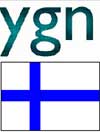 |
|---|---|
This years YGN Technical tour to Finland took place between the 7th and 12th June. We chose to return to Finland again after the excellent feedback received following the 2005 YGN tour. How many people attended from the UK? |
The event was organised by Alan Ruiz of Halcrow Group Ltd and Tommi Henttonen of Fortum Nuclear Services Ltd (Finland). The aim of the tour was to provide an insight into the Finnish Nuclear industry and provide delegates the opportunity to network with like minded young professionals throughout Europe.
Day 1 kicked off with a coach journey 3 hours north of Helsinki to Olkiluoto which is operated by Teollisuuden Voima Oyj (TVO). TVO is a private limited company founded in 1969 by 16 industrial and power companies to produce electricity for its shareholders at cost price. Today TVO has over 100 shareholders who have purchased a percentage of the organisation which gives them use of a predetermined quantity of electricity (dependant on the shares held).
TVO operates two Swedish designed boiling water reactors (Olkiluoto 1 and 2) on behalf of its shareholders and does not make any profit, as any profit is again invested in new plant such as the new Olkiluoto 3 Evolutionary Power Reactor (EPR) being constructed currently by Areva in a ca £3bn turn-key contract.
The Olkiluoto 1 and 2 reactors have been running for about 30 years with capacity factors consistently in the region of 97%. Each reactor has a net output of 860 MW, and together they produce around 16% of Finland’s energy requirements. With the Olkiluoto 3 EPR due to connect to the grid in 2012, the Olkiluoto plant will contribute 32% of Finland’s energy needs.
Waste heat from the reactors is used to heat soil and the air in the most northerly vineyard in the world where TVO make there own ‘TVO’ branded wine; and the heat is piped to a large warehouse building where the company breed crawfish to sell at cost to local farmers and fishermen who sell it on at profit. This is all very far removed from the UK system of generation where profit is king!
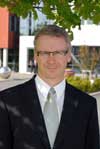 |
The group were welcomed by TVO President Mr Jarmo Tanhua who highlighted the challenges being faced by the Finnish nuclear industry and how these were similar to the challenged experienced in the UK. Jarmo emphasised the importance of encouraging young people into the industry, developing professional networks which cross international borders and talked of the nuclear renaissance in Finland. Jarmo Tanhua (pictured) “It is a bright time for Finland and a bright time for nuclear” |
|---|
The welcome presentations at Olkiluoto continued with a discussion on the various projects across the site to increase the output from the reactors and a presentation on reactor safety by Mr Juha Poikolainen, Head of Reactor Safety.
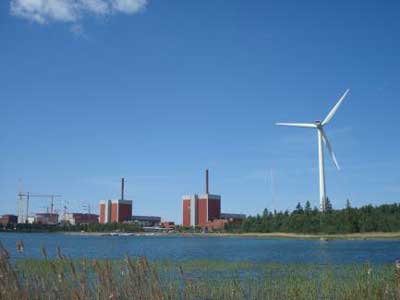
The visit included guided tours of the Olkiluoto 1 turbine hall where delegates could see, hear and feel the 860MW turbine supply electricity to TVO’s shareholders, and a tour of the reactor charge face, giving all the opportunity to see first-hand the fuel storage ponds and reactor pressure vessel. A tour of the spent fuel storage ponds followed where everyone could get up close and personal with the fuel assemblies in their matrices, below several metres of crystal clear pond water – something most of the group were experiencing for the first time!
 |
The group were then let loose at the excellent visitors centre during the Monday afternoon. The interactive displays described the “Uranium Cycle” showing how it is mined, used in a reactor and then the final disposal facility being constructed at Onkalo. The centre included a cloud chamber where background radiation could be seen in front of your own eyes and a genuine copper fuel disposal flask. A genuine reactor pressure vessel bolt capable of withstanding 732 tons and approx 5ft long was also on display (pictured). The group all agreed that it was the best visitor centre that they had visited. The visitor centre is visited by approx 20,000 visitors per year, including tourists, school children and now the UK YGN! |
|---|
Hospitality was provided on Monday evening by TVO with the exclusive use of their Raumolina Social Club which included a meal and some refreshments with the YGN working at Olkiluoto. The evening included the traditional Finnish sauna (one of only around 2m in Finland!) and plunging into the ice cold Baltic Sea! Fun was had by all, well mostly!

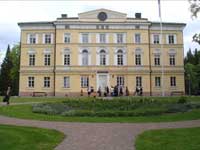 |
The tour continued on the Tuesday morning with a series of presentations by Posiva at their offices at Vuojoki Mansion. Posiva is owned 60% by TVO and 40% by Fortum, Finland’s other main nuclear operator and is responsible for Finland’s deep geological disposal facility at Onkalo. The presentations were by Ms Vesa Ruuska of Posiva who discussed the licensing process for the deep geological repository, Mr Jani Helin, a geologist specialising in deep geological disposal, presented on the rock characteristics and finally |
|---|
Ms Hanna Kajader presented on the infrastructure required in Olkiluoto to support the Olkiluoto 3 project and the deep geological repository construction at Onkalo. A brief visit to the Onkalo repository then followed.
The Finnish government requires that all nuclear waste generated in Finland must be handled and stored in Finland. It also requires that high active wastes and spent fuel be disposed of adjacent to an existing nuclear site, hence the location at Olkiluoto. The current plan is for spent fuel sub assemblies to be placed into a steel matrix (12 per matrix) and these are then placed into a copper flask weighing 7 tonnes. The current best estimate is that 2,900 of these flasks, each weighing 15 tonnes once full of fuel, will be sent to Onkalo and cemented into vertical storage positions surrounded by bentonite clay.
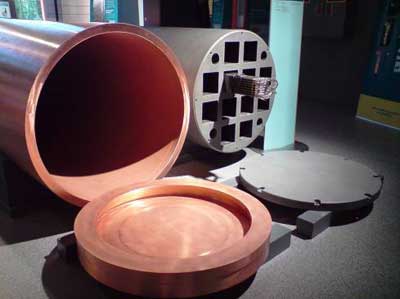
The Onkalo repository will be capable of taking all fuel and high active wastes from all existing nuclear reactors in Finland and the new EPR being built at Olkiluoto. In addition, provision has been made to expand the store for any potential new reactors such as the application for Olkiluoto 4 by TVO, Loviisa 3 by Fortum and the new build application by Fennovoima.
Geological feasibility studies were undertaken during the 70s and the Olkiluoto location chosen in 2001. To date the access tunnel has been partially complete with an underground rock lab being built to establish the fitness for purpose of the site for long term geological disposal. Depending on the findings of that investigation the decision will be made by the Finnish government to either progress with the Onkalo repository or investigate alternative locations. All being well, construction of the final repository is scheduled to begin in 2012 with operation in 2018.
Tuesday morning also included a tour of the TVO operated LLW and ILW underground storage facility which is situated approx 75m underground, extending some 60m further in 2 large cylindrical vaults.
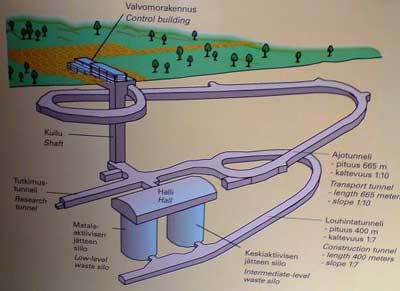
The last stop on the Olkiluoto tour was to a viewing platform overlooking the site of the Olkiluoto 3 EPR construction site. Olkiluoto 3 is widely recognised by our hosts as the future of Finnish nuclear power, and perhaps the UK?
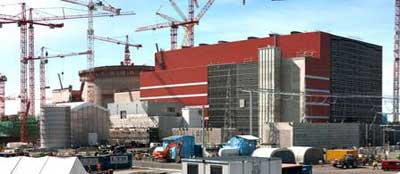
Wednesday started with the annual Finnish YGN seminar that had been organised at the office of Fortum Nuclear Services in Helsinki. The event included presentations from the UK Tour attendees including the UK’s new build programme and BE merger with EdF delivered by Katy Jones and Gareth Thomas of BE/EdF, a discussion of the purpose of the Dalton institute by Warren Jones and a presentation by Stephen Le Clere on the decommissioning challenge faced at Sellafield. The Finns presented on the regulatory process for new build, highlighted the large number of research projects being undertaken on the OL 3 project and on their ambitions for new build beyond OL 3. The presentations will be made available late in 2009 on the Finnish YGN website – www.ats-fns.fi/info/arkisto.html

Thursday morning was spent visiting the operating VVER stations at Loviisa (a 1h drive from Helsinki) which are operated by Fortum. The VVER design is similar to the PWR but a Russian design. The tour included a number of presentations giving a brief overview of the design followed by a tour of the containment building. Entry procedures were extremely strict with our hosts insisting that clean socks and coveralls were worn whilst inside the station! |
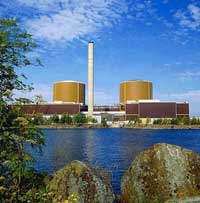 |
Before lunch the group were taken to the Fortum operated LLW and ILW disposal facility – some 150m below ground. After lunch the group headed back to the offices of Fortum Nuclear Services in Helsinki where they listened to a number of talks from leading nuclear specialists and the president of nuclear generation support for Fortum. The presentations focussed on the decommissioning strategy for Loviisa and the site assessment for the proposed construction of a third nuclear plant at Loviisa.
Thursday evening was a great opportunity for the group to meet with the staff from Fennovoima, a new company formed recently to build a new nuclear reactor in Finland. The organisation, like TVO is non-profit making and is owned by around 65 shareholders (EoN Nordic hold 33%) in a similar way to the shareholders in TVO. In relation to new build in Finland, there are currently 3 applications lodged with the Finnish Government. One by TVO who wish to build another reactor at Olkiluoto (OL4), Fortum Nuclear Services who wish to build a new reactor at Loviisa in the East of Finland (this proposal includes an option for an approximately 70 km underground stream pipe to heat homes in Helsinki) and Fennovoima who wish to build at one of 4 sites across the country. A Decision in Principle is expected in 2010 from the Finnish government.
The tour was concluded on Friday morning with a series of presentations by the Finnish regulator, STUK. These included NPP Licensing in Finland - Feasibility Studies and Preliminary Safety Assessment for Desicion in Principle by Janne Nevalainen, Challenges in the Olkiluoto 3 Project by Kirsi Alm-Lytz and a general presentation on the Finnish regulatory system. The visit also included a tour of the emergency response centre at STUK’s offices.
In a country where every second street light has been turned off to save on electricity and ultimately cost, there is a lot of national debate on the reasons for the delays to Olkiluoto 3. STUK and the Finnish utilities believe that the rest of the world should be made aware of the problems that they have faced in the construction of the EPR at Olkiluoto, so that lessons can be learned for future new build projects. Unsurprisingly, STUK (and TVO during our visit earlier that week) maintain that the construction license for OL3 was granted based on a scheme design, and that the detailed design of systems associated with EC&I and other complex safety systems that was submitted for regulatory approval had been delayed. Further delays were also incurred during construction with quality issues surrounding the concrete foundations etc. STUK was keen to highlight the importance of collaborative working between utilities, regulators and manufacturers for future new build. These presentations can be viewed on the YGN website under the “Documents” tab.
Overall the visit was a great success for all involved and the YGN. An excellent mix of technical presentation, site tours and socialising was achieved thanks to the organisation and hospitality offered by the Finnish YGN. In particular thanks must go to Fortum, TVO, Fennovoima and STUK for their assistance in organising the 2009 YGN Technical Tour.
Further info can be found online:
www.nuclearinst-ygn.com/pic/main.php?g2_itemId=29 – Event Photos
www.tvo.fi/www/page/etusivu_en
www.fortum.com
www.stuk.fi
www.posiva.fi/en
www.fennovoima.fi/en
http://www.euronuclear.org/e-news/e-news-26/nucnet-news.htm


NucNet - How do you view the British government’s progress on new build in the UK? What needs to be done?
Tindale: Opposition to nuclear energy is less widespread than it was. For example, I expected many
environmentalists to be very rude to me, and some have been, but not very many. Both Labour and
Conservative (two of the UK’s main political parties) are in favour of nuclear now. The planning system holds
up everything in the UK. The Labour government is setting up the Infrastructure and Planning Commission,
which is basically trying to take the politics out of planning decisions. The problem is that the Conservatives
are opposed to the Commission and have said that they will change it if they come into power. That may be
one thing that holds up new nuclear development.
NucNet – What kind of energy mix should the UK should be aiming for?
Tindale: I think the UK’s target to get 15 percent of energy generation from renewables by 2020 is essential and must be met, but it’s unlikely that we could get any more than that by 2020. We need to stop arguing about which is the best of the low-carbon options and accept that we need to pursue all of them, including nuclear, and pay for all of them, and that it won’t be cheap. It’s important to be up front and honest about the fact that this will mean more expensive electricity generation.
NucNet - The Scottish government has set a target of 20 percent of electricity to be generated by renewables by 2020. Is this attainable?
Tindale: It is attainable but they need to upgrade the Beauly-Denny power line, on which the government has not been taking too many decisions in the past few years. (Beauly-Denny is a proposed 400,000 volts overhead electricity transmission line which will replace the existing 132,000 volts transmission line between Beauly, west of Inverness, and Denny, west of Falkirk).
NucNet - Your switch from an anti-nuclear stance, to arguing for nuclear power as a means to help tackle climate change is well-publicised. How did you reach this decision?
Tindale: Melting permafrost in Siberia was yet more confirmation that climate change was more serious
than had been thought. That was one major factor that made me switch, but I think the other important point
was that the use of electric vehicles is beginning to take off, and should be pursued and promoted. But once
we have electric vehicles, then it is even more important to have low carbon electricity, as there will be an
increase in demand for electricity in Europe, and worldwide.
NucNet - What are your views about the way radioactive waste should be dealt with? Do you support the idea of a deep geological repository in the UK?
Tindale: First of all, I am still concerned about it, but fossil fuels also produce waste. Put crudely, it’s better to keep the waste down here than it is to put it up into the atmosphere. Waste should be kept in a way which is safe from terrorist attack and theft, but also in a way which means it is monitorable and retrievable.
NucNet - There is much discussion about the need for the nuclear industry to ‘engage with the public’. What does the nuclear industry need to do to get its message across?
Tindale: It needs to be more frank about the costs, particularly if you take decommissioning and waste management costs into the equation, which you should and must, and the fact that I think this is more expensive than unabated coal. But it won’t destroy the climate, so it is a price worth paying. I believe most of the public will accept that, but it’s important for the industry to be more up front about that than it has been at times in the past, such as when nuclear was cited as ‘too cheap to meter’.
NucNet - Do you still hold reservations about nuclear?
Tindale: My view has always been that the main danger or drawback of nuclear energy is weapons
proliferation. It’s difficult to say we should have more nuclear power in the UK or Europe, but not in other
countries. So the Kissinger-Nunn proposal for an international nuclear fuel cycle – or internationallycontrolled
nuclear fuel cycle, which President Obama has now picked up and is supporting – is a sensible
way forward.
* Stephen Tindale is co-founder of Climate Answers and a climate and energy consultant. His past roles include executive director of Greenpeace UK, and advisor to former UK environment minister Michael Meacher. Mr Tindale says too much of the discussion on climate change is still about “what we should not be doing or what we should be against”. He says there is not enough discussion or information on solutions– what countries can and should do to minimise dangerous climate change.
Climate Answers: www.climateanswers.info
UK Department of Energy and Climate Change: www.decc.gov.uk
Nuclear White Paper 2008 – Meeting the Energy Challenge:
www.decc.gov.uk/
UK Health & Safety Executive New Nuclear Power Stations: www.hse.gov.uk
The IAEA said on 27 October 2009 that the collaborative effort aims to give researchers, academics, and the general public access to “vast volumes of valuable research” on the safe and peaceful uses of nuclear energy.
The IAEA said that its International Nuclear Information System (INIS) preserves nuclear knowledge by digitising historic nuclear energy research documents dating from 1970 through to the early 1990s so that they can be processed by computers.
The DOE project is one of the larger programmes in the INIS project, and includes more than 180,000 documents from the DOE’s Office of Scientific and Technical Information – which is the US representative to INIS and has had its own digitisation programme in recent years.
The INIS database inisdb.iaea.org), which contains 3.1 million bibliographic records and 225,000 full-text documents, was opened to the public for free, unrestricted, online access in April 2009.
The study* on environmental effects of thermal and radioactive discharges from nuclear plants in the boreal brackish-water conditions of the northern Baltic Sea was published last month as a report from the Finnish Radiation and Nuclear Safety Authority (STUK).
STUK said the results are based on hydro-biological and radio-ecological analyses from monitoring programmes and environmental studies carried out over more than 40 years in the sea areas surrounding the country’s Loviisa and Olkiluoto nuclear power plants.
Loviisa is on the coast of the Gulf of Finland and Olkiluoto is on the coast of the Bothnian Sea. The areas of sea surrounding the two plants differ from each other in many ways, the study says.
“For example, the exchange of water, the nutrient concentrations and the salinity of the water are different. In addition to local divergences, the amounts of discharges and the way the plants discharge their cooling waters also deviate from each other.”
However, it is common for both plants that thermal discharges have increased the eutrophication process in the water.
Radioactive discharges into the sea from Finnish nuclear plants have been clearly under the statutory discharge limits, the study says. “During the whole operational history of the power plants the effective dose commitments of the critical groups have been at their highest less than 4 percent, and during recent years clearly below 1percent of the set limit that is 0.1 millisieverts per year.”
The study says those belonging to the ‘critical groups’ of the highest dose spend a lot of time by the sea and eat an abundance of local fish. “Similarly, the impact of the radioactive discharges to the environment was negligible, far below the international screening level set for organisms.”
*Principal adviser Erkki Ilus presented his doctoral thesis on 25 September 2009 at Helsinki University. The report is available in English in the publications section of STUK’s website (www.stuk.fi).
– by John Shepherd
>>Related reports in the NucNet database (available to subscribers)
Finland Needs More Nuclear Capacity In Long-Term, Says Energy Strategy Report (News No. 88, 7 November 2008)
Source: NucNet
Editor: editors@worldnuclear.org
http://www.euronuclear.org/e-news/e-news-26/other-conferences.htm


11 - 14 November 2009
Veliko Tarnovo, Bulgaria
Bulgarian Nuclear Society
E-mail: pripesho@inrne.bas.bg

15 - 19 November 2009
Washington, DC
United States of America
American Nuclear Society Meetings
Department,
555 North Kensington Avenue, LaGrange Park,
IL 60326, USA
Tel: +1 (708) 352-6611
Fax +1 (708) 352-6464
E-mail meetings@ans.org
www.ans.org
7 - 11 December 2009
Kyoto, Japan
Conference Services Section
Division of Conference and Document Services
Tel: +43 1 2600 21311
Email: official.mail@iaea.org
www.fr09.org

7 May 2010
Brussels, Belgium
SCK.CEN, ISI IRE, IBA, EITA and BNS
Prof. Em. Michel Giot
michel.giot@sckcen.be
more
11 - 12 May 2010
Brussels, Belgium
Foratom
Tel: +32 2 502 45 95
Email: info@ena2010.org
more

16 - 20 May 2010
Dubrovnik, Croatia
Croatian Nuclear Society
Unska 3
10000 Zagreb
Croatia
Tel: + 385 1 6129 627
E-mail: hnd@cro-nuclear.hr
more
12-18 July 2010
Cape Town, South Africa

29 August - 2 September 2010
at the Shilo Inn Convention Center in Idaho Falls, Idaho, USA
Teri Ehresman
Assistant General Chair
Tel: (208) 526-7785
Fax: (208) 526-2930
Email: teri.ehresman@inl.gov
more
26 to 30 September 2010
Avignon, France
Patricia Hamel-Bloch
SFEN
5 rue des Morillons
F-75015 PARIS
Tel: 33.1.53.58.32.12
Fax: 33.1.53.58.32.11
Email: phamel-bloch@sfen.fr
more
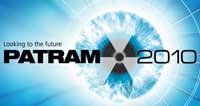
3 - 8 October 2010
London, United Kingdom
Department for Transport of the United Kingdom
more

9th International Conference on Tritium Science and Technology
24 - 29 October 2010
Nara, Japan
National Instiute for Fusion Science Safety and Environmental Research
http://www.euronuclear.org/e-news/e-news-26/Member-Societies.htm

Austrian
Nuclear Society |
Belgian
Nuclear Society |
Bulgarian
Nuclear Society |
Croatian
Nuclear Society |
Czech Nuclear Society |
Finnish
Nuclear Society |
French
Nuclear Energy Society (SFEN) |
German
Nuclear Society (KTG) |
Hungarian
Nuclear Society |
The
Israel Nuclear Society |
Italian
Nuclear Association |
Lithuanian
Nuclear Energy Association |
Netherlands Nuclear Society |
The Nuclear Institute |
Nuclear
Society of Russia |
Nuclear
Society of Serbia |
Nuclear
Society of Slovenia |
Polish
Nuclear Society |
Romanian
Nuclear Energy Association (AREN) |
Slovak
Nuclear Society |
Spanish
Nuclear Society |
Swedish
Nuclear Society |
Swiss
Nuclear Society |
http://www.euronuclear.org/e-news/e-news-26/Corporate-Members.htm

Links to ENS Corporate Members
|
http://www.euronuclear.org/e-news/e-news-26/editorial.htm
Mark O’Donovan, Editor-in-Chief
Contributors to this Issue:
David Bonser (ENS)
David Dalton (NucNet)
Kirsten Epskamp (ENS)
Lars Persson (KTH)
Frigyes Reisch (KTH)
Andrew Teller (Areva)
Wim Uyttenhove (BNS-YG)
Thomas Winkler (Swiss YGN)
Realisation:
Marion Brünglinghaus
Rue Belliard 65, BE-1040 Brussels
Phone +32 2 505 30 50 - Fax: +32 2 502 39 02
E-mail: info@euronuclear.org - http://www.euronuclear.org
The ENS News is a quarterly publication, in electronic
form only.
Copyright notice ©2009 European Nuclear Society.
Reproduction is authorised provided that the ENS News is acknowledged as the
source – except where otherwise stated.
![]()
© European Nuclear Society, 2009